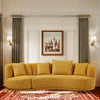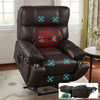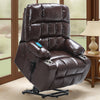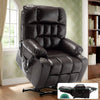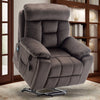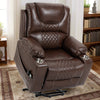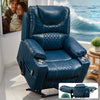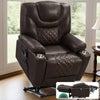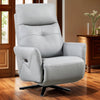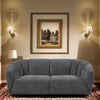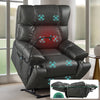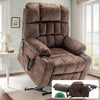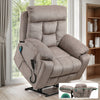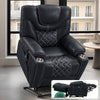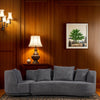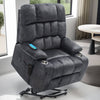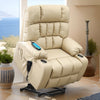Understanding the Importance of High Resilience Foam for Seniors
The Science Behind High Resilience Foam
High Resilience (HR) foam is a type of polyurethane foam that's revolutionizing senior comfort. It's made with a unique chemical structure that allows it to bounce back quickly after compression. This foam has a higher density and more open cell structure than traditional foam. These properties make it ideal for recliners for elderly people.

HR foam offers better support and durability. It maintains its shape and firmness over time, which is crucial for seniors who spend long hours seated. The foam's molecular structure allows for better air circulation, reducing heat buildup and moisture retention. This feature is especially important for seniors who may have difficulty regulating body temperature.
The Impact on Comfort and Health
The use of HR foam in recliners has a significant impact on senior comfort and health. Its superior support helps maintain proper posture, reducing the risk of back pain and muscle strain. The foam's ability to distribute weight evenly prevents pressure points, which can lead to discomfort and even bedsores in extreme cases.
HR foam's quick recovery property ensures that the recliner maintains its shape. This consistency is vital for seniors who may have difficulty adjusting their position frequently. The improved air circulation helps keep the skin cool and dry, reducing the risk of skin irritation and infections.
Moreover, the foam's durability means that seniors can enjoy consistent comfort for longer periods. This longevity is not just about comfort; it's also about maintaining independence and quality of life for older adults.
Comparing With Traditional Foam Types
When compared to traditional foam types, HR foam stands out in several ways. Standard polyurethane foam tends to compress and lose its shape over time. This can lead to a "sinking" feeling and reduced support. Memory foam, while comfortable, can retain heat and may be difficult for seniors to move in and out of.
HR foam, on the other hand, offers a balance of comfort and support. It provides the softness of memory foam without the heat retention. Unlike traditional foam, HR foam doesn't break down as quickly, maintaining its supportive properties for much longer.
In terms of durability, HR foam outperforms both standard and memory foam. This longevity is particularly beneficial for seniors, as it means less frequent need for furniture replacement. The consistent support also means better posture and comfort over extended periods.
Selecting the Right Recliner for Elderly Care
Key Features to Look for in a Senior Recliner
When choosing a recliner for seniors, several key features should be considered:

- Ease of operation: Look for recliners with simple, easy-to-use controls.
- Sturdy construction: The recliner should be stable and able to support the user's weight.
- Proper sizing: Ensure the recliner fits the user's body size for optimal comfort.
- Smooth reclining mechanism: The transition between positions should be gentle and smooth.
- Easy-to-clean upholstery: This is important for maintaining hygiene.
- Safety features: Such as anti-tip design and locking mechanisms.
- Lift assistance: Some recliners offer a lift feature to help seniors stand up easily.
The presence of HR foam in the seat and backrest should be a priority. This ensures long-lasting comfort and support for the elderly user.
How High Resilience Foam Can Improve Quality of Life
HR foam in recliners can significantly enhance the quality of life for seniors. The consistent support it provides helps maintain good posture, reducing the risk of back pain and related issues. This can lead to improved mobility and independence.
The foam's pressure-relieving properties can help prevent bedsores, a common concern for seniors with limited mobility. By distributing weight evenly, HR foam reduces pressure on any single point of the body. This can lead to better circulation and reduced risk of skin breakdown.
The improved air circulation in HR foam helps regulate body temperature. This can be particularly beneficial for seniors who struggle with temperature regulation. It can lead to more comfortable and restful periods of sitting or sleeping in the recliner.
Top Recommendations for Senior Recliners on the Market
While specific brand recommendations may vary, here are some general types of recliners that are often recommended for seniors:
- Power lift recliners: These help seniors stand up easily.
- Wall-hugger recliners: Ideal for small spaces, they require less room to recline.
- Massage recliners: Offer additional comfort and potential health benefits.
- Swivel recliners: Allow for easy repositioning without standing up.
- Heat and vibration recliners: Provide extra comfort and potential pain relief.
When choosing, always prioritize models that incorporate HR foam in their construction. This ensures the best combination of comfort, support, and durability for senior users.
Implementing High Resilience Foam in Healthcare Settings
The Role of High Resilience Foam in Aging Care Services
In aging care services, HR foam plays a crucial role in enhancing comfort and preventing health issues. It's used not just in recliners, but also in beds, wheelchairs, and other seating solutions. The foam's ability to maintain shape and provide consistent support is invaluable in these settings.

HR foam helps reduce the risk of pressure ulcers, a common problem in long-term care facilities. Its even weight distribution and pressure-relieving properties are key in this regard. The foam's durability also means less frequent need for furniture replacement, leading to cost savings for care facilities.
Moreover, the improved comfort can lead to better sleep and rest for residents. This can have a positive impact on overall health and well-being. The foam's temperature-regulating properties also contribute to a more comfortable environment for seniors.
Benefits of Using High Resilience Foam in Rehabilitation Centers
In rehabilitation centers, HR foam can significantly enhance the recovery process. The consistent support it provides is crucial for patients who may need to spend extended periods seated or lying down. This can help prevent secondary complications that might arise from poor posture or pressure points.
The foam's quick recovery property is particularly beneficial in rehab settings. As patients move or are repositioned, the foam quickly regains its shape, ensuring consistent support. This can be especially important for patients with limited mobility or those recovering from surgeries.
HR foam's durability is also a key advantage in high-use environments like rehab centers. The foam maintains its properties even with frequent use, ensuring patients receive consistent support throughout their recovery journey.
Strategies for Integrating High Resilience Foam into Furniture Management Programs
To effectively integrate HR foam into furniture management programs:
- Conduct a needs assessment to identify areas where HR foam can be most beneficial.
- Gradually replace older furniture with HR foam-equipped options.
- Train staff on the benefits and proper use of HR foam furniture.
- Implement a regular inspection and maintenance schedule for HR foam furniture.
- Collect feedback from users to continually improve comfort and support.
By prioritizing HR foam in furniture choices, healthcare settings can significantly enhance comfort and care quality for seniors. This investment in quality can lead to improved patient outcomes and satisfaction in the long run.







